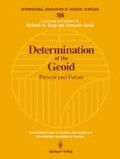Abstract
The optimal combination of surface gravity data with the OSU86F geopotential model (GM) complete to degree and order 360 is studied in a North-American test area. Experiments using gravity data and different truncations of the geopotential expansion are carried out in order to obtain for absolute geoidal heights an accuracy close to 0.40m and for relative geoidal heights 2–3 ppm. These results have been derived by comparing the computed gravimetric geoidal heights and corresponding heights derived from GPS. The same GM is employed with and without the additional use of gravity and height data in a second test area (Greece) in order to predict components of the deflections of the vertical. The results indicate an accuracy better than 2“. Conclusions for optimal combination of the 360x360 GM with regional gravity data and topographic heights are drawn and are verified numerically by the prediction of different quantities related to the gravity field.
Access this chapter
Tax calculation will be finalised at checkout
Purchases are for personal use only
Preview
Unable to display preview. Download preview PDF.
References
Arabelos, D. (1985). Evaluation of deflections of the vertical using topographic-isostatic and astrogeodetic data for the area of Greece, Bull. Géod. 57, 109–123.
Bracewell, R. (1978). The Fourier transform and its applications,2nd ed., McGraw Hill, New York.
Forsberg, R. (1984). A study of terrain reductions, density anomalies and geophysical inversion methods in gravity field modelling, Dept. of Geod. Sci. Rep. 355, Ohio State Univ., Columbus.
Forsberg, R. (1985). Gravity field terrain effect computations by FFT. Bull. Géod. 59, 342–360.
Heiskanen, W.A. and Moritz, H. (1967). Physical Geodesy, W.H. Freeman and Company, San Francisco and London.
Kearsley, A.H.W. (1986). Data requirements for determining precise relative geoidal heights from gravimetry, J. Geophys. Res. 91, 9193–9201.
Lachapelle, G. (1975). Determination of the geoid using heterogeneous data,Ph. D. Thesis. Mitt. Geod. Inst., Folge 19, Graz.
Moritz, H. (1972). Advanced least squares methods, Dept. of Geod. Sci. Rep. 175, Ohio State Univ., Columbus.
Rapp, R.H. (1981). The earth’s gravity field to degree and order 180 using SEASAT altimeter data, terrestrial gravity data and other data, Dept. of Geod. Sci. Rep. 322, Ohio State Univ., Columbus.
Rapp, R.H. and Cruz, J.Y. (1986). Spherical harmonic expansions of the earth’s gravitational potential to degree 360 using 30’ mean anomalies, Dept. of Geod. Sci. Rep. 376, Ohio State Univ., Columbus.
Schwarz, K.P. and Sideris, M.G. (1985). Precise geoid heights and their use in GPS interferometry, Geodetic Survey of Canada Contract Report No. 85–004, Ottawa, Ontario.
Schwarz K.P., Sideris, M.G. and Forsberg, R. (1987). Onhometric heights without levelling, Journal of Surveying Engineering 113, 28–40.
Sideris, M.G. (1985). A fast Fourier transform method for computing terrain corrections, Manuscripta Geodaetica 10, 66–73.
Sideris, M.G. and Schwarz, K.P. (1986). Improvements of medium and short wavelengths features of geopotential solutions by local data, Proc. of the Int. Symp. on the Definition of the Geoid, pp. 50–576, Firenze, Italy.
Tscherning, C.C. (1981). Comparison of some methods for the detailed representation of the earth’s gravity field, Rev. Geophys. Sp. Phys. 19, 213–221.
Tziavos, I.N. (1987a). Determination of geoidal heights and deflections ofthevertical for the Hellenic area using heterogeneous data, Bull.Geod. 61, 177–197.
Tziavos, I.N. (1987b). Comparison of the gravity spectrum as derived from a 360x360 geopotential model and regional gravity data, Presented at the XIX IUGG General Assembly, Vancouver, B.C., August 9–22.
Author information
Authors and Affiliations
Editor information
Editors and Affiliations
Rights and permissions
Copyright information
© 1991 Springer-Verlag New York Inc.
About this paper
Cite this paper
Tziavos, I.N., Arabelos, D. (1991). Estimation of the Disturbing Potential Components and Comparison with GPS and Astrogeodetic Data. In: Rapp, R.H., Sansò, F. (eds) Determination of the Geoid. International Association of Geodesy Symposia, vol 106. Springer, New York, NY. https://doi.org/10.1007/978-1-4612-3104-2_16
Download citation
DOI: https://doi.org/10.1007/978-1-4612-3104-2_16
Publisher Name: Springer, New York, NY
Print ISBN: 978-0-387-97470-5
Online ISBN: 978-1-4612-3104-2
eBook Packages: Springer Book Archive

